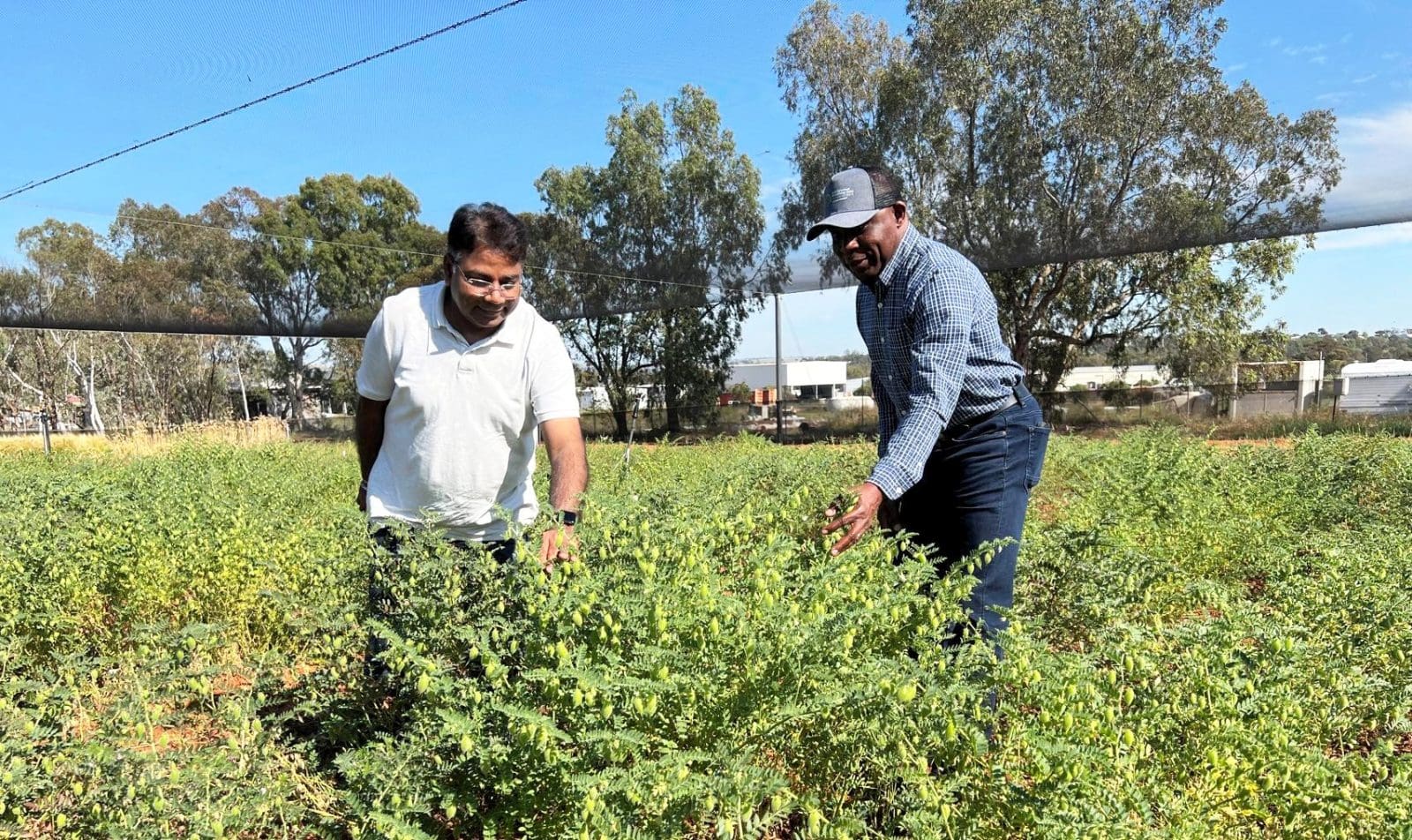
Prof Rajeev Varshney and Dr Francis Ogbonnaya inspect a trial planting of chickpeas. Photo: CCFI
RESEARCHERS from the Centre for Crop and Food Innovation at Murdoch University have led the generation of a pan-genome tailored specifically to Australian chickpea varieties, paving the way for improved chickpea production across the country.
The comprehensive genetic resource, composed of high-quality assemblies of the 15 most popular chickpea varieties grown by Australian farmers, uncovered previously uncharacterised genetic diversity.
This is expected to prove essential in understanding and improving desirable agronomic traits that underpin the success of the nation’s chickpea production, including yield, flowering time, acid soil tolerance and drought tolerance.
Analysis was conducted in collaboration with Chickpea Breeding Australia, Agriculture Victoria Research, the WA Department of Primary Industries and Regional Development, the UWA Institute of Agriculture, and BGI Research.
It identified 34,345 gene families, including 13,986 dispensable families enriched for genes associated with key agronomic traits, with findings published this week in the Plant Biotechnology Journal.
The research pinpointed structural variations that influence flowering time, seed weight, disease resistance, drought resilience, and acid soil resilience, highlighting a major opportunity to expand the genetic base of Australian chickpeas and ultimately support the long-term sustainability of chickpea production in Australia.
The researchers also discovered that Australian varieties could be further improved through the introduction of the “QTL hotspot” region for drought tolerance that has already demonstrated a 15-22 percent yield advantage after its introgression in elite cultivars in India, Ethiopia, Kenya and Tanzania.
CCFI is now working with industry partners to introgress the QTL-hotspot for drought tolerance into Australian varieties and deliver them to chickpea growers.
Reporting on the findings, report co-author and CCFI director Professor Rajeev Varshney said the Australian chickpea pan-genome heralds a significant step in safeguarding future production, as it enables acceleration of the development of chickpea varieties tailored to each region.
“That could mean varieties that are more drought-resilient and acid soil-tolerant in Western Australia and nationally, and more resistant to diseases like Ascochyta Blight.
“We look forward to working with breeding organisations to get new and improved varieties into the hands of Australian farmers.
The Grains Research and Development Corporation is the anchor partner in Chickpea Breeding Australia, and GRDC senior manager for oilseeds and pulses Francis Ogbonnaya said the research was “ground-breaking”.
“It is fantastic to see the country’s leading chickpea researchers unite to develop a significant genetic resource critical towards securing the future productivity and sustainability of chickpeas in increasingly challenging growing conditions,” Dr Ogbonnaya said.
“By unlocking the genetic diversity within the crop, this research provides a powerful foundation for breeding chickpea varieties with improved drought resilience and abiotic stresses, directly addressing some of the most pressing challenges for Australian grain growers.”
CBA chickpea breeder Kristy Hobson said these findings fill in some much-needed knowledge gaps regarding the genetic makeup of Australian chickpea varieties, which will be essential for further improvement through identifying the genes responsible for yields, stress tolerance and disease resistance.
“Since the release of Australia’s first commercial chickpea variety in the 1970s, our industry has flourished into a billion-dollar sector that produced over 2 million tonnes of chickpea last season, and one of the world’s major chickpea exporters,” Dr Hobson, who is based in Tamworth, NSW, said.
“However, there are significant challenges, including changes in agricultural practices, shifts in market demands, soil constraints, and significant disease pressures.”
Source: Murdoch University

HAVE YOUR SAY